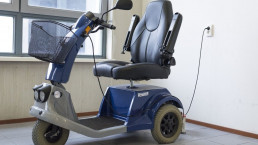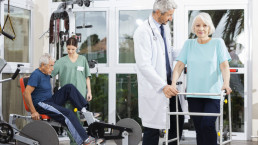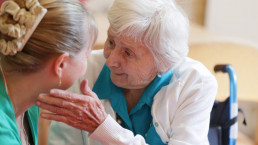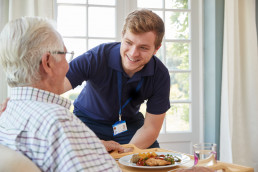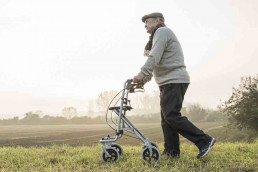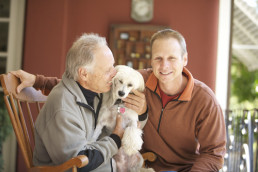Power Chair Safety: Tips for Use in a Skilled Nursing Facility, at Home, and in the Community
A manual wheelchair could be assigned to just about anyone because it offers stationery use as well as voluntary self-propulsion at calm speeds.
When a motor is added, upgrading the seated contraption into a power chair, red flags should be popping up indicating serious safety precautions.
The user now has access to immediate self-propulsion with a jerk of the joystick, granting them high speeds for indoor and outdoor use.
If user receives appropriate training, then using the power chair provides enhanced and safe mobility around their home and their community.
However, if a power chair is handed to anyone with limited to zero training and with no consideration for physical/cognitive capabilities, the end result could be disastrous for the user and those in their surrounding environment.
The following are a few tips to promote safe use of a power chair in three settings: a skilled nursing facility, a private home, and in the community.
Consult with primary physician and specialists: Before you get “Click to Order” button-happy, consider the benefits of consulting with a specialist and undergoing an evaluation first.
Like a car, you would not allow a person with severe dementia or with bilateral glaucoma drive a motorized chair. If potential users, family members, or caregivers have concerns regarding vision, cognition, or any deficit that could lead to injury to the user or to others while operating the chair, make the wise decision to seek out a safety evaluation.
Participate in power chair use training: For patients who reside in a skilled nursing or long-term care setting, medical staff may be bound by specific policies regarding power chair evaluations and use.
For example, residents who receive a doctor’s order to be fitted for a power chair will have to undergo several steps including: a consultation with a wheelchair specialist and a rehabilitation therapist (usually occupational or physical therapy), training in a demo chair conducted by the therapist, and evaluations to obtain insurance coverage for the chair.
For persons who are buying the chair for private residential use, it is recommended to consult with a medical equipment specialist about correctly operating the chair for indoor and outdoor use.
Opt for a demo or a rental: If you live at home and/or you are worried about whether or not you can safely use a power chair in your living space, contact a medical equipment company about renting or borrowing a demo chair.
Rentals means delaying financial commitment to your own chair while providing you time to select a chair that fits your body type, fits in your home, and fits your daily needs for mobility at home and in the community.
Read the Instructions: Specifically, brush up on the user manual for the chair’s intended purposes. Too often, users attempt to propel power chairs over rough and unpredictable terrain when the chair was never designed for outdoor use.
If you need a chair for both indoor and outdoor use, thoroughly research power chairs that can meet your criteria to minimize damage to the chair and to yourself.
Prepare for the worst scenario: When going on a community outing with a power chair, be prepared for the worst circumstances: medical emergencies and chair stalling.
Wear weather-appropriate clothing to reduce exposure injuries. Bring plenty of water, snacks, and back-up medication. Have the chair battery fully charged before departing and bring the charger with you.
Pack a fully charged cellphone and the charger for complete emergency access. Always tell someone where you are going and when you plan on returning home.
Bring a chaperone with you: If you are new to using a power chair, don’t be shy and ask someone to supervise you. It could be for a simple jaunt around the facility, reversing out of a tight space, or taking a community outing.
Make sure that the chaperone fully understands that if the chair stalls or tips that it is not their responsibility to push or catch the chair. In order to avoid injury and to have complete access to emergency personnel, the chaperone is responsible for making the 9-1-1 call or recruiting others for assistance.
Occupational Therapy for Senior Citizens: What It Looks Like and How It Can Help You
According to the American Occupational Therapy Association (AOTA), the general scope of Occupational Therapy (OT) is defined as follows:
“Occupational therapy is the only profession that helps people across the lifespan to do the things they want and need to do through the therapeutic use of daily activities (occupations). Occupational therapy practitioners enable people of all ages to live life to its fullest by helping them promote health, and prevent—or live better with—injury, illness, or disability."
Let’s take a step back and review what this means for the senior population.
Older adults receive OT in a variety of settings including outpatient clinics, home health agencies, hospital (intensive care, inpatient), skilled nursing facilities, assisted living facilities, community-based settings, and specialty private practices.
In each setting, OT provides certain interventions according to the patient’s goals as well as to what they can ethically/legally bill for per facility.
The following are just a few examples of what OT addresses when it comes to senior care:
Activities of Daily Living (ADLs): This includes basic tasks that the senior individual wants to or needs to complete: showering, dressing, toileting, mobility, self-feeding, and hygiene completion.
OT’s goal would be not to complete the tasks for the person, but to restore the person’s capabilities of independently completing the tasks themselves.
Instrumental activities of Daily Living (IADLs):
Areas include financial management, medication management, community activities, driving, spiritual or religious participation, cooking, meal preparation, and household cleaning tasks.
Believe it or not, many OTs working in a skilled nursing, transitional unit, or inpatient setting will address these complex tasks if the patient finds it necessary before discharging safely home.
Fall prevention and recovery:
Some OTs are trained in carrying out fall prevention and fall recovery programs, which is very relevant to senior needs since falls and inability to recover from falls frequently occurs with this population.
Adaptive Equipment:
OTs are the go-to clinicians for explaining how to use unrecognizable medical equipment including: reachers, shoe horns, sock aids, shower chairs, toilet risers, long-handled sponges, wide-handled spoons, plate guards, and the list goes on.
OTs will introduce adaptive equipment when functionally necessary and instruct the patient and/or caregivers how to safely use it to fulfill their daily living tasks.
Family/Caregiver education:
Education regarding exercise programs, orthotic programs, adaptive equipment, and safety in the home comes in handy when patients are getting ready to discharge home.
Instead of leaving caregivers in an uncomfortable and unfamiliar situation, OT helps fill the gaps by providing information and resources about how to transition care into the home environment.
Orthotics:
Some post-surgical or post-traumatic conditions require acute or long-term bracing or splinting to promote joint and muscle healing.
Examples include post-stroke deficits such as shoulder subluxation, hypertonicity or muscle atrophy through an upper extremity, etc. Others could be slings or braces for post-surgical shoulder conditions.
OT could address several items: assessment and fitting for a brace/splint, implementation of a wear schedule, program development for maintenance and cleaning, and program development for a wear schedule to be carried out at home by others if necessary.
Manual Therapy techniques:
“Manual” includes any hands-on techniques that promote healthy joint movement and circulation to tissue.
Patients who may benefit from manual therapy are those who have trouble voluntarily moving a limb due to pain, lack of movement, or lack of sensation.
Therapeutic exercise:
OT provides exercise regimens that are relevant to the patient’s functional goals.
For example, if a patient wishes to transfer independently from their wheelchair to a toilet seat but lacks the upper body strength to pull up on the grab bar, then OT would create an upper body exercise program to address the weaker muscle groups.
Physical Modality Agents (PAMs):
This includes complex machinery including E-stimulation units, ultrasound units, heating pads, paraffin baths, contrast baths, cryotherapy tools, or any agent used for pain management and promotion of functional movement.
OT usually supplements a PAM with other interventions including ADLs/IADLs, manual therapy, or therapeutic exercise.
Sources:
https://www.aota.org/Conference-Events/OTMonth/what-is-OT.aspx
Appropriate Evaluation of a Skilled Nursing Facility: A Tool for Patients and Families
Although patients and families are welcome to cruise online and look up “Yelp!” reviews, there are other ways to accurately research skilled nursing facilities.
Before diving in, think about the questions that you want answered:
What does the patient want in a facility?
Even though family members may have facility preferences, they will not be staying the night…the patient will. So, in the end it boils down to what the patient wants to see in the facility so please don’t ignore their preferences.
How close is the facility to my home?
Some families and patients prefer to be close to home for convenience purposes. This means that families can drop off items from home, visit more frequently without having to drive too far, and have close access to the facility in the event of medical changes, team meetings, or emergencies.
What are visiting hours like?
Call or check each website for the facilities in which you are interested in. Make sure you know for certain what visiting hours look like, and how many people are allowed to visit at a time.
Are the staff easy to contact during the day?
If the patient is staying in a fairly large facility, there is a chance that family/caregivers will be put on hold before talking to staff members. If you are okay with the wait and want to stay at a large, reputable facility then go with that. If you’re honestly inpatient and prefer not to be put on hold then explore smaller facilities.
Will the facility provide me my own room or will I be sharing with another patient?
This really depends on facility policies and patient caseload. It never hurts to call the facility and ask about whether or not the patient can have their own room.
Is there a smoking area?
Some skilled nursing facilities are simply doing away with outdoor smoking areas. However, if a smoking routine is important to you then call the facility and ask if a space is available.
What are the satisfaction ratings on each facility?
Go to each and every individual website per facility that you research. Somewhere on the website should be a link to the latest satisfaction ratings as posted by previous patients and families at the facility.
What facilities will take my insurance?
This is a factor in which it doesn’t hurt to check, double check, and triple check. Some patients rely on hospital staff to locate skilled nursing facilities within your healthcare provider network.
Do the safe route and personally contact your insurance companies about coverage for the facilities in which you are interested in. Ask what services (if not all of them) insurance will cover and for how many days.
In conclusion:
Once you have created a list of questions that you would like answered, research each facility website or personally call each facility in regards to your inquiries.
Relying heavily on public reviews won’t provide you with as much information as you think.
Additionally, always know that you can make more than one phone call if necessary.
If you found a good facility, the staff members there will be happy to assist you until you are satisfied.
Avoid Coronavirus Scams
Source: https://www.consumer.ftc.gov/features/coronavirus-scams-what-ftc-doing
Scammers are taking advantage of fears surrounding the Coronavirus.
Here are some tips to help you keep the scammers at bay:
Hang up on robocalls. Don’t press any numbers. Scammers are using illegal robocalls to pitch everything from scam Coronavirus treatments to work-at-home schemes. The recording might say that pressing a number will let you speak to a live operator or remove you from their call list, but it might lead to more robocalls, instead.
Ignore online offers for vaccinations and home test kits. Scammers are trying to get you to buy products that aren’t proven to treat or prevent the Coronavirus disease 2019 (COVID-19) — online or in stores. At this time, there also are no FDA-authorized home test kits for the Coronavirus.
Fact-check information. Scammers, and sometimes well-meaning people, share information that hasn’t been verified. Before you pass on any messages, contact trusted sources.
Know who you’re buying from. Online sellers may claim to have in-demand products, like cleaning, household, and health and medical supplies when, in fact, they don’t.
Don’t respond to texts and emails about checks from the government. The details are still being worked out. Anyone who tells you they can get you the money now is a scammer.
Don’t click on links from sources you don’t know. They could download viruses onto your computer or device.
Watch for emails claiming to be from the Centers for Disease Control and Prevention (CDC) or experts saying they have information about the virus. For the most up-to-date information about the Coronavirus, visit the Centers for Disease Control and Prevention (CDC) and the World Health Organization (WHO).
Do your homework when it comes to donations, whether through charities or crowdfunding sites. Don’t let anyone rush you into making a donation. If someone wants donations in cash, by gift card, or by wiring money, don’t do it.
What the FTC is Doing
The FTC and FDA have jointly issued warning letters to seven sellers of unapproved and misbranded products, claiming they can treat or prevent the Coronavirus. The companies’ products include teas, essential oils, and colloidal silver.
The FTC says the companies have no evidence to back up their claims — as required by law. The FDA says there are no approved vaccines, drugs or investigational products currently available to treat or prevent the virus.
Source: https://www.consumer.ftc.gov/features/coronavirus-scams-what-ftc-doing
The Signs at Home: When It’s Time to Consider Memory Care
Throughout California, some facilities offer special memory care services.
With that in mind, what exactly is memory care?
The broad definition says that it is a specific type of long-term care tailored to meet the needs of individuals with Alzheimer’s disease, dementia, and other forms of memory deficits. Staff, who receive dementia training, provide 24-hour supervisory and nursing care in order to monitor medical needs and activities of daily living of the residents.
Family members and caregivers of aging adults with Alzheimer’s/dementia are fully aware that symptoms are not usually the result of an immediate onset; rather, symptoms progressively worsen over any given length of time.
This progression can sometimes make it difficult to gauge if or when the elderly individual requires more help.
So, what signs are caregivers/family members looking for when it comes time to transition a person with dementia from a private home to memory care?
Aging adults with mild Alzheimer’s or dementia can typically function well at home for a time, probably with occasional assistance from family members or caregivers for more complex tasks including (but not limited to):
Grocery shopping, finances, medication management, cooking/meal preparation, or community access and transportation.
Moderate to severe cases of Alzheimer’s or dementia dramatically change how a person conducts the basics at home, and safety becomes the main issue.
Example situations may include the following:
- Forgetting to use an ambulation device (walker, cane, etc.) to get around the house can be a serious problem if the individual has terrible standing balance.
- Wandering out of the house and not knowing how to get back
- Turning on kitchen appliances and not turning them off when finished or using them unsafely.
- Falling out of bed by simply trying to get up
- Inability to complete dressing, showering, toileting, and hygiene needs without cuing or maximum assistance from others.
- Lashing out or turning aggressive towards caregivers, making it near to impossible for them to receive help for functional tasks.
There should be massive applause for family members and caregivers who dedicate their lives to assisting persons with severe dementia so that they may reside at home.
However, there are some cases where it can prove too much.
Caregivers who may have limited physical capacity or deteriorating health themselves eventually have to get help (i.e. aging spouses), and there is no shame in it.
Consider these three questions:
1.) Is the person with dementia safe in their own home or can be left alone at any time?
2.) Are there family supports in place that are successfully working to keep the person safe at home?
3.) Are home health options in place AND working?
If the answer is NO to all of these questions, then it is time to consider something like out-of-home placement or memory care.
When to Consider Assisted Living/Board Care vs. Living at Home
Caregivers and family members who are new to residential care options for their elderly loved ones may be unfamiliar with knowing when the appropriate time has come.
For some, the following questions may have already crossed your mind?
- What is residential care?
- How does someone qualify for assisted living outside of their home?
- What signs am I looking for that make assisted living a suitable option for the elderly adult?
- Where does the line fall between transitioning to assisted living and recruiting assistance for home?
First, one assumption needs to be cleared up:
Just because somebody is elderly does not mean that they automatically belong in an assisted living facility.
Many elderly adults live out the rest of their lives at home safely and efficiently. However, some elderly individuals live with specific circumstances in which assisted living becomes a viable choice.
Now, let’s break down and assess some of the red flags that family members/caregivers should be monitoring.
Three main reasons why the benefits of assisted living would outweigh the benefits of living at home:
- The elderly adult can no longer complete necessary, functional tasks at home safely and independently.
- The elderly adult lacks a support system (family, friends, caregivers, guardians, etc.).
- Professional home health is not working (i.e. not available or not improving the safety of the elderly adult functioning at home).
The following items are observable examples of why an elderly adult may not be able to complete certain tasks independently and safely within their own home:
Poor posture and balance: This only becomes a problem if there is an increase in falls, an inability in getting to other rooms safely (the bathroom, the bedroom, the kitchen, the stairs, etc.).
Severe loss of balance should be a red flag if certain compensation measures have been taken and aren’t working such as use of a walker, a cane, or a wheelchair.
Incontinence: In general, incontinence is a disruption in typical toileting patterns for bladder and bowel removal. This could include medical problems concerning the bowel and bladder, the physical inability to get to a toilet independently, long-term use of catheters or colostomy bags, etc.
Incontinence without assistance leads to filthy living environments, infection, and skin breakdown/wounds.
Memory changes: Increased forgetfulness or loss of memory is common with aging adults. It becomes a safety concern when the home becomes a hazard or when tasks become dangerous: forgetting to turn off the oven, leaving doors unlocked, overdosing on or forgetting to take medication, or wandering off and having no memory of how to get home.
In some instances, standard assisted living care. In more severe cases of memory loss, memory care placement should be part of the discussion.
Vital problems: Persons with respiratory, diabetic, or cardiac-related illnesses may have trouble living at home independently if maintaining healthy vitals (heart rate or respiratory rate) is an issue.
This may include difficult in independently managing blood pressure medication, glucometer readings and insulin, prescribed diets, and supplemental oxygen.
Remember, elderly adults living at home have the option of exploring home health supports as well as increasing those supports when changes arise. Assisted living comes into play when home health supports no longer provide safe living at home anymore.
Note: Residential care or assisted living in California are non-medical facilities, so certain medical conditions that require specific nursing attention may not be allowed.
Preventing Falls at Home for Older Adults Using Today’s Technology and Products
The healthiest person can still experience a fall by pure accident or due to poor choices.
That being said, for the elderly it is not a matter of “if” they fall….it’s “when” they fall.
Reduced vision, decreased cognition, unstable standing balance, and generalized weakness/fatigue are just a few of the many fall-related factors that older adults experience simply due to the aging process.
Thanks to available medical technology and equipment, ground-level falls at home can be minimized.
Here are a few suggestions:
1. Cane - For mild standing balance weakness, a single-point cane or a quad cane could provide enough external support to prevent loss of balance.
Some older adults may handle indoor surfaces well enough without a cane, but reserve the option for outdoor use in order to scale rougher surfaces.
Persons who are thinking about incorporating a cane need to be able to weight-bear comfortably through both feet and have complete functional use of at least one arm.
2. Walkers/Rollators - If a cane is not good enough and the user is still experiencing a loss of balance, it may be time to upgrade to a walker.
For standard walker use, the older adults needs two functioning arms and needs to be able to comfortably weight-bear through at least one foot.
A walker provides more support for people who struggle standing up straight while walking. For individuals who fatigue easily, rollators come with a seat for periodic rest breaks.
3. Grab Bars - Installing grab bars is a great method for preventing an older adult from stabilizing on shaky objects like towel racks, oven doors, door knobs, top-heavy furniture, and wheeled chairs.
Grab bars could be placed just about anywhere in the house, but priority rooms should include the bathroom, the kitchen, and the bedroom.
Older adults conduct a lot of movement and transfers in all three rooms (getting out of bed, sitting on the toilet, climbing into the shower, getting dressed, etc.) over slippery surfaces, thus cultivating some major fall zones in the house.
4. Non-Slip Mats - Floor mats that provide some friction in connection to the floor and the bottom of the feet are helpful when placed on slippery bathroom floors and tiled/wooden floored living rooms and kitchen areas.
The mats need to be thin and well-adhered to the floor in order to prevent tripping or catching on the feet.
5. Seat Risers - Risers on the toilet or on dinner chairs help prevent “partial” falls. If the older adult has leg weakness (specifically in the quadriceps and hamstrings), a successful sit-to-stand transfer can turn into a lowering move to the floor.
A riser provides compensation for weakness, meaning that the individual doesn’t have to recruit as much muscle power to stand or sit.
6. Non-Slip Socks - Hospitals regularly hand out non-slip socks to fall-risk patients, but older adults are welcome to purchase the same socks for home use.
The bottom of the sock is lined with a rubber, friction-friendly material that prevents the wearer from slipping on smooth surfaces like tile, wood, linoleum, and cellar cement.
7. Bed Rails - Bed rails serve a similar purpose as seat risers in that, if properly used, assist a person getting in and out of bed by reducing muscle power to stand up or sit down.
An incomplete transfer could mean sliding off of the bed and onto the floor. Low-priced high quality bed rails can be located just about anywhere online, and the installation features are a frugal option over getting an expensive hospital bed.
8. Stair-Lifts - It’s a common fall prevention technique to avoid the stairways in a house. Unfortunately, some older adults don’t have that option in split-level homes, residences with steps up to the entryway, or houses where stairs must be scaled to get to the essential rooms (kitchen and bathroom).
Installation and parts can be expensive, but placing a stair-lift in the house could completely eliminate dangerous tumbles on stairways all-together.
9. Threshold Covers - Small door or room thresholds could be a huge tripping hazard for older adults who struggle with lifting their feet high enough to clear low-flying obstacles. Threshold covers or wedges can minimize the height.
5 Things to Look for in Incontinence Products
When an elder is diagnosed with incontinence, he or she might quickly become overwhelmed by the options of incontinence products that are on the market.
There are hundreds of products ranging from pads to adult diapers, and this can make it hard to narrow down which product is best for the individual.
If you’re a care taker or an elder who suffers from incontinence, it’s important for you to know how to choose the right product.
So, to help you weed out the best products, here are a few things to look for when buying incontinence products.
1. Size
Size is a crucial factor that often determines how well a product will work for the user. If the wearer isn’t wearing the correct size of product, he or she will likely have to deal with uncomfortable leakage and accidents.
Most incontinence products range in size from extra small to triple large, allowing wearers of every size to find the perfect fitting product. By wearing the right size, the wearer will feel more secure and confident, as well as be more relaxed and open to enjoying life despite their incontinence.
2. Gender
Most incontinence products are gender specific. Some are better suited for men, while others are better suited for women. While this doesn’t seem like a big deal, buying incontinence products based on the gender of the wearer is important.
Why? This is because extra protection is put in place where each gender needs it most.
3. Severity
Always consider how severe the wearer’s incontinence is before purchasing an incontinence product. For some wearers, the incontinence is only a minor issue and doesn’t require a lot of protection, but for others the incontinence can be severe and mean that he or she needs a strong product to put the issue to rest.
The products are made with all incontinence cases in mind, and products can be found for people who need only light protection to those who need full protection such as a person who has lost bladder or bowel control.
4. Frequency
How frequently the incontinence occurs is something to think about when buying incontinence products. As a rule of thumb, people who suffer from severe incontinence are more likely to suffer from it frequently, and people who have mild incontinence are likely to only suffer sometimes. This can mean the difference between the wearer needing strong or light protection.
5. Comfort
Although incontinence sufferers aren’t usually happy about having to use incontinence products, the products shouldn’t be uncomfortable. If they are, the wearer should try a different kind of product or a different size.
Each wearer has a preference, and this preference should be honored as incontinence is a life-long problem and won’t go away regardless of which type of product is used.
In Conclusion
It’s important to remember that incontinence products aren’t one-size-fits-all products.
Each person who needs them has different likes and dislikes, and different reasons for needing the products.
Their personal comfort, incontinence frequency and severity, gender, and body type should all be considered before a product is purchased.
The Skilled Nursing Rehab Team: A Q&A for Families
As a new admit to a skilled nursing facility, the patient and involved family members will be professionally bombarded by many healthcare providers from multiple departments: social work, nursing, psychiatry, recreational therapy, nutrition, respiratory therapy, rehabilitation, and administration to name a few.
Let’s hone in on and breakdown one department: the rehabilitation (or rehab) team.
This team typically involves three specialties: occupational therapy (OT), physical therapy (PT), and speech and language pathology (SLP).
Since the patient will be spending a good chunk of time with potentially all three therapies, it is very natural for the patient and their family to have questions about what these providers do.
Here are few commonly asked questions, followed by summarized answers in order to assist families and patients who might draw a blank when approached by therapy:
What is OT? PT? SLP?
Therapists love getting asked this question because they get to talk about themselves and promote their profession. Here are some basic descriptions:
OT, specifically in skilled nursing settings, offers education, restoration, and adaptive techniques to increase independence in daily living tasks such as showering, toileting, dressing, hygiene completion, cooking, household cleaning, medication management, community reintegration, and driving to name a few.
PT will take a primary focus on ambulation (walking), functional mobility (bed mobility, wheelchair use, transfers, etc.), body strengthening and activity tolerance through therapeutic exercise, and ambulation device training (i.e. crutches, walkers, wheelchairs, scooters, etc.).
SLP hones in on speech or language related needs as well as cognitive and swallowing deficits. Unlike PT and OT, SLP is certified to diagnose swallowing deficits (i.e. dysphagia), set up feeding precautions, and order scans or tests to confirm or rule out swallowing difficulties.
Do I have to have all three?
Not necessarily, and that will be determined by each initial evaluation. Each therapist will separately meet the patient soon after admission into the facility, conduct evaluations made up of standardized assessments and clinical observations. After the evaluation is completed, the therapists will consult with the team as well as the rehab director about whether or not the patient is clinically appropriate for all three.
How much time will I be spending with each therapist?
This is determined by two factors, depending on which facility you are staying in: clinical appropriateness and insurance. Based on initial evaluation, each therapist submits an order to be signed by the overseeing primary physician recommending a certain number of visits. The duration of each treatment is determined by a combination: what your insurance is willing to pay for and the number of minutes you can physically tolerate. Sometimes, therapists will break up treatments, maybe seeing a patient for half of their time in the morning and the rest of their time in the afternoon.
Do I get to pick my therapist?
Don’t worry about hurting anyone’s feelings. As a patient, it is common to develop better rapport with one therapist over another. Feel free to suggest that you would like to see a particular therapist. Keep in mind, however, that if you are consistently seeing a therapy assistant (OTA or a PTA) your sessions will be interrupted every few days by a visiting OT or PT who is qualified to update your plan-of-care.
Can I schedule my therapy around other appointments and visits from family?
Yes, to a certain degree. If your family plans to visit you all day, then it might be near to impossible to NOT interrupt visitation. Family members who are privy to your medical information, or are those you approve of, are welcome to attend your therapy sessions. Medical appointments outside of your facility that take up the whole day may require postponing therapy until the next day.
What if I don’t want therapy?
Unfortunately, part of the reason you are admitted to a skilled nursing facility is to receive rehab services. If this is a problem, contact administration about your dilemma while keeping in mind that your insurance might not pay for your stay if you avoid rehab
When can I go home?
This can be a difficult question because the answer is rarely clean-cut. Discharge from skilled nursing is determined by the interdisciplinary team as a whole. The rehab team offers the rest of the facility updates about the patient’s progress and whether or not they feel they can safely return home. Patients and relevant family members are encouraged to attend these meetings to offer their own input about discharge.
Benefits of Identifying Alzheimer’s Early: A Rehabilitative Perspective
No aging adult wants other people pointing out times when their cognition slides.
Misplacing items, forgetting names, repeating stories…it’s all commonly part of the aging process and many older adults get embarrassed by it. In order to preserve their pride, they try to brush these slip-ups aside and in the end there is no harm and no foul.
On the other hand, there are times when these cognitive slip-ups result from much more than just the aging process.
Occasionally, these are early signs of Alzheimer’s disease or some form of dementia. Again, the slip-ups are brushed aside to avoid embarrassment. Unfortunately, these symptoms get dismissed and early identification of Alzheimer’s disease is lost.
So, what is the big deal? So what if an individual doesn’t get diagnosed with Alzheimer’s disease as early as they should?
The Alzheimer’s association has identified 10 early signs and symptoms of Alzheimer’s which includes confusion with time or place, memory loss, difficulty with solving problems, and misplacing things.
They emphasize that the symptoms all have something in common: they cause a major disruption to function and to daily life.
Alzheimer’s disease (not including early-onset Alzheimer’s) typically effects adults 65 years and older. Being familiar with the early signs and symptoms leads to early diagnosis.
Here are some of the benefits of obtaining and early diagnosis:
Getting a more accurate diagnosis.
Obtaining an early diagnosis gives your specialists more time to properly diagnose you. There are several sub-types of dementia, all of which require a variety of prescriptive and rehabilitative approaches.
Treating reversible symptoms.
In rare cases, there are some Alzheimer’s-like conditions that can be reversed if identified early enough. This includes encephalopathic conditions in which liquid and inflammation builds up around the brain tissue. Visit the NIH Neurological Institute information page regarding normal pressure hydrocephalus.
Early rehabilitation treatment.
This includes getting access to physical, occupational, and speech therapy treatment in your home and in healthcare settings. Such professionals can assist you with maintaining your level of independence in tasks that mean the most to you for as long as possible.
Rehabilitative specialists can also work with family members and caregivers, providing education on how to facilitate your independence and what to expect as the disease changes over time.
Having control in planning your living situation.
Early identification means having the cognitive capacity to decide what your one living situation will look like as the disease progresses.
Options include living at home with family, applying for assistive living, deciding hospice care and advanced directives if and when the time comes.
Preparing your family for what’s to come.
Alzheimer’s disease obviously impacts the affected individual, but the functional loss that comes with the disease directly impacts relevant family members and caregivers.
This involves spouses, siblings, and other family members completely transforming their relationship to the role of caregiver. Early identification helps better prepare them for how their roles will change in order to best care for you.
- 1
- 2
